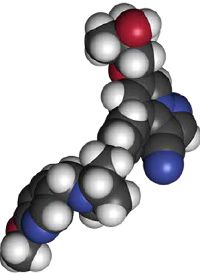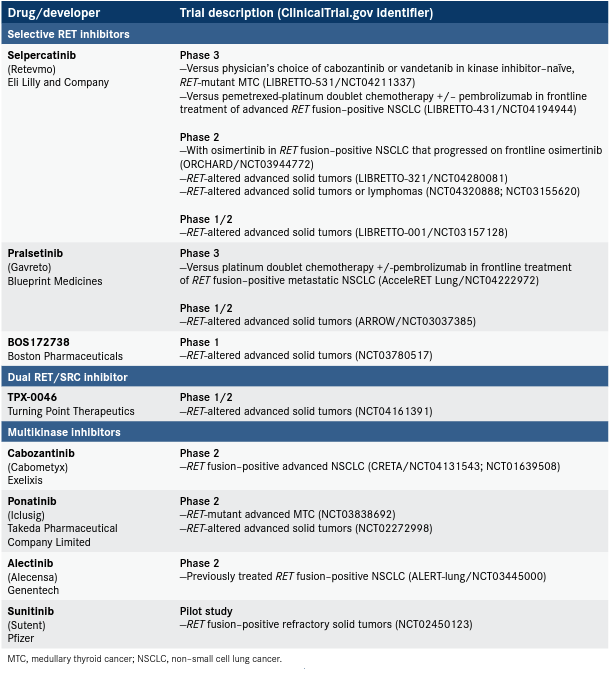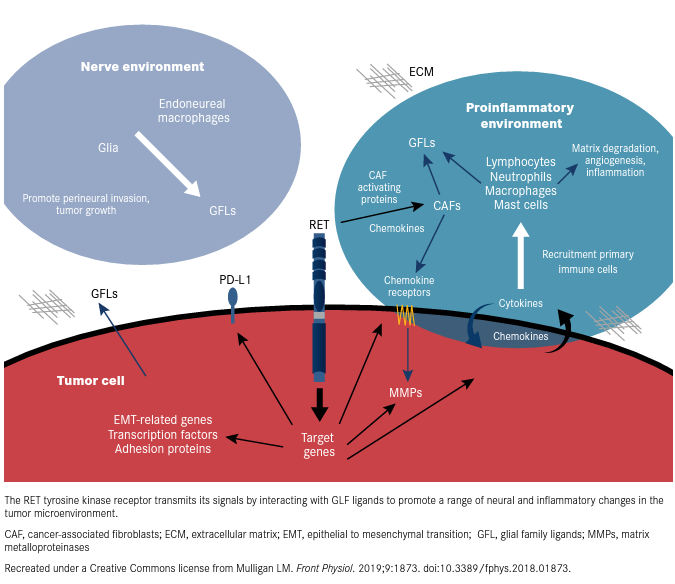Publication
Article
RET Joins the Ranks of Actionable Targets in Precision Oncology
Author(s):
Over the past 2 decades, a growing number of targetable tumor-specific molecular alterations have been identified, ushering in the era of precision oncology. Now, alterations in the RET gene can be added to the list of druggable targets.

Over the past 2 decades, a growing number of targetable tumor-specific molecular alterations have been identified, ushering in the era of precision oncology.1 Now, alterations in the RET gene can be added to the list of druggable targets.2,3
RET is not a new target; it was first linked to cancer more than 30 years ago. RET-directed therapeutics have included multikinase inhibitors with RET among their targets.2,3 Although several are approved for the treatment of thyroid cancers, which frequently display RET alterations, RET biomarker testing is not required.4-7
In less than a year, the FDA has approved 2 selective RET inhibitors, selpercatinib (Retevmo) and pralsetinib (Gavreto) for the treatment of patients with advanced non–small cell lung cancer (NSCLC) harbor-ing a RET fusion and for RET-altered thyroid cancers.8-10
Selective RET inhibitors have demonstrated potent and durable efficacy in patients with RET-altered tumors, including those with RET mutations that confer resistance to multikinase inhibitors.11-14 Building on past experience with targeted therapies, investigators have begun to anticipate novel mechanisms of resistance to these agents.2,15
TPX-0046, a next-generation inhibitor of both RET and a second kinase, SRC, has demonstrated preclinical efficacy against one such mechanism of resistance, RET solvent front mutations, and is already in clinical development.16
RET alterations occur infrequently outside of thyroid cancer. However, the advent of next-generation sequencing (NGS) technologies has revealed their presence in a growing number of tumor types, suggest-ing a tumor-agnostic role for RET inhibitors in the future.2,3,17 The clinical development of selective and multitargeted RET inhibitors is underway for approved and novel agents, according to ClinicalTrials.gov (Table).
Table. Ongoing Clinical Trials Targeting RET Alterations

RET Kinase Signaling
Under normal conditions, RET signaling plays a vital role in a number of cellular processes, including development of the central and peripheral nervous systems as well as the kidney.3,18
Aberrant RET activity has been linked to cancer development since the 1980s. Its name, which stands for REarranged during Transfection, reflects its oncogenic role; RET was first discovered as a gene that was rearranged following transfection of mouse embryonic fibroblasts with human lymphoma DNA.3,19
The RET tyrosine kinase receptor transmits its signals by interacting with the glial cell line derived neurotrophic factor (GDNF) family of ligands, including GDNF, neurturin, artemin, and persephin (Figure18). These structurally related growth factors bind to corresponding nonsignaling membrane coreceptors, GDNF family receptor alpha (GFRA) 1 to 4. Each ligand binds preferentially, but not exclusively, to a distinct GFRA coreceptor. The GDNF ligands and GFRA coreceptors are expressed in overlapping but different tissue types, endowing each complex with somewhat unique cellular functions.3,18,20
Figure. RET Activity in the Tumor Microenvironment18

Other than not binding ligands directly, RET functions as a typical tyrosine kinase receptor. Its activation is initiated when 2 GDNF ligands form a homodimer that binds a pair of GFRA coreceptors. This ligand-coreceptor complex brings together 2 RET molecules, leading to RET autophosphorylation at key tyrosine residues.3,18,20
These phosphorylated tyrosine residues serve as docking sites for adaptor molecules, which subsequently activate downstream signaling pathways, including the MAPK and PI3K/AKT pathways.3,18,20
RET As An Oncogenic Driver
Thyroid Cancer
Oncogenic alterations in the RET gene in the form of gene fusions were first identified in patients with papillary thyroid cancer (PTC).21 Current estimates suggest that RET fusions occur in 10% to 20% of sporadic PTCs, with the highest incidence in patients who have been exposed to environmental or therapeutic radiation.3,19,22
RET gene fusion results from a chromosomal rearrangement or inversion, and the ensuing chimeric protein consists of RET’s C-terminal kinase domain juxtaposed with the N terminus of another protein. This fusion partner commonly contributes a dimerization domain, leading to constitutive activation of RET kinase activity in the absence of any ligand.3,18,22 Among patients with PTC, the most frequently observed RET fusion partners are CCDC6 and NCOA4.2,3,22
Gain-of-function point mutations in RET also have been found in patients with thyroid cancer. Initially linked to multiple endocrine neoplasia 2, an inherited cancer syndrome characterized by a high risk of medullary thyroid cancer (MTC), RET mutations subsequently have been identified in 40% to 65% of sporadic MTC cases, in which their presence correlates with more aggressive disease. RET mutations can occur at numerous sites in the gene but are seen predominantly within either the extracellular or kinase domain. Most common is the M918T kinase domain mutation, accounting for nearly 70% of sporadic MTC cases.18,23
NSCLC
In 2012, RET fusions were first identified in NSCLC, and subsequent studies demonstrated a prevalence of approximately 1% to 2%. RET fusions are observed primarily, although not exclusively, in patients who lack other driver alterations, such as EGFR mutations and ALK gene fusions. In terms of structure and oncogenic mechanism, RET rearrangements in NSCLC and thyroid cancer are similar; however, the most common fusion partner in NSCLC is the KIF5B gene.2,19,22
RET fusions associated with NSCLC are more prevalent in younger patients who have never or rarely smoked and whose tumors have adenocarcinoma histology and are more poorly differentiated.3
Other Tumor Types
In recent years, aberrant RET signaling has been identified in a growing number of tumor types beyond thyroid and lung cancers. In an NGS study of 4871 patients with diverse malignancies, RET mutations were identified in small numbers of patients with paraganglioma and ovarian, bladder, and colorectal cancers, among others.17 In many cases, the functional relevance of RET mutations remains to be determined. RET fusions also have been identified at low frequencies in cancer types such as salivary gland, ovarian, colorectal, and pancreatic.22
High levels of RET protein expression have been reported in many malignancies, including breast, prostate, and pancreatic cancers. Notably, RET expression occurs in approximately 40% of breast tumors24 and has been found to correlate with resistance to endocrine therapy in estrogen receptor–positive breast cancer.
Multikinase Inhibitors
Given the key role of aberrant kinases in the development of cancer, a number of multitargeted kinase inhibitors have been developed and approved for the treatment of several cancer types. Some of these drugs include the RET protein among their targets because its kinase domain is similar in sequence and structure to that of other tyrosine kinases.
Cabozantinib is approved as Cometriq for the treatment of metastatic MTC (a different dosage form under the brand name Cabometyx is approved for other indications25), as is vandetanib (Caprelsa).4,5 Meanwhile, sorafenib (Nexavar) and lenvatinib (Lenvima) are approved for the treatment of radioactive iodine–refractory differentiated thyroid cancer (DTC).6,7 However, these approvals do not require patients to have RET alterations, and patients were enrolled in the pivotal phase 3 trials that led to FDA approval irrespective of RET mutation status.
Exploratory analyses in the EXAM trial (NCT00704730) demonstrated that cabozantinib was superior to placebo in patients with MTC, with the greatest benefit—in terms of increased overall response rate (ORR), progression-free survival (PFS), and overall survival—in patients with the RET M918T mutation compared with patients with other RET mutations or wild-type RET.26 In the ZETA trial (NCT00410761) of vandetanib in MTC, subgroup analyses of ORR and PFS produced inconclusive results when patients were stratified by general RET mutation status. However, similar to what occurred in the EXAM trial, the M918T-positive group derived greater benefit than the M918T-negative group.27 Neither pivotal trial for lenvatinib or sorafenib approval in DTC investigated the impact of RET alteration status on patient outcomes.3
Multikinase inhibitors have been studied in patients with RET-rearranged NSCLC, and modest efficacy was reported. However, use of these drugs is limited by the development of resistance and significant toxicity, the latter partly resulting from concomitant inhibition of VEGFRs.2
RXDX-105 is a VEGFR-sparing multikinase inhibitor developed by Ignyta to address this issue. Data from a phase 1 basket trial (NCT01877811) in patients with RET fusion–positive solid tumors were reported. The ORR was 19%, and the majority of treatment-related adverse events (TRAEs) were grade 1 or 2.28 Roche subsequently acquired Ignyta, however, and development of this drug was discontinued.29
The ORRs reported for multikinase inhibitors in RET-altered NSCLC were lower than those observed with more specific kinase inhibitors in patients with NSCLC driven by other oncogenes,2 prompting a search for more selective RET inhibitors with greater potency and reduced toxicity.
Two such drugs, pralsetinib and selpercatinib, rapidly advanced through clinical trials and recently received FDA approval for the treatment of RET fusion–positive NSCLC; RET-mutant MTC; and RET fusion–positive, radioactive iodine–refractory thyroid cancer.8-10
First-In-Class Selpercatinib
Accelerated approval of selpercatinib was based on the ongoing, open-label, phase 1/2 LIBRETTO-001 trial (NCT03157128) conducted at 65 centers across 12 countries. In the phase 1 dose-escalation portion, patients received doses of selpercatinib ranging from 20 mg once daily to 240 mg twice daily, and in the phase 2 dose expansion, they were treated with 160 mg twice daily. Results from the trial were recently reported, with separate publications detailing outcomes for 2 different patient groups.12,13
Of 144 patients with RET fusion–positive advanced NSCLC who received selpercatinib, 105 were previously treated (49 in dose escalation and 56 in dose expansion; median of 3 prior lines of systemic therapy) and 39 were treatment naïve.12
The ORR in previously treated patients was 64% (95% CI, 54%-73%), including 2 complete responses (CRs) and 65 partial responses (PRs). An additional 30 patients achieved stable disease. Responses were observed regardless of the type of prior therapy received. Median duration of response (DOR) was 17.5 months (95% CI, 12 months–not evaluable [NE]), with 63% (95% CI, 42%-67%) of responses ongoing at a median follow-up of 12.1 months. One-year PFS was 66% (95% CI, 55%-74%), and median PFS was 16.5 months (95% CI, 13.7 months–NE).
Notably, among 11 previously treated patients with measurable central nervous system (CNS) metastases at baseline, the intracranial ORR was 91% (95% CI, 59%-100%), including 3 CRs and 7 PRs, and median CNS DOR was 10.1 months (95% CI, 6.7 months–NE).
The ORR in treatment-naïve patients was 85% (95% CI, 70%-94%), with 90% of responses ongoing at 6 months, and neither median DOR nor median PFS had been reached at a median follow-up of 7.4 and 9.2 months, respectively.12
The second LIBRETTO-001 report described findings for 162 patients with thyroid cancer who were treated across 3 cohorts.13 In the first cohort, 55 patients with RET-mutant MTC previously treated with cabozantinib and/or vandetanib had an ORR of 69% (95% CI, 55%-81%), including 5 CRs and 33 PRs. Responses were observed in patients with various types of RET mutations, including gatekeeper mutations at residue V804 that confer resistance to multikinase inhibitors. At 1 year, 86% (95% CI, 67%-95%) of responses were ongoing, and 1-year PFS was 82% (95% CI, 69%-90%).
In the second cohort, 88 patients with RET-mutant MTC not previously treated with cabozantinib or vandetanib achieved an ORR of 73% (95% CI, 62%-82%), including 10 CRs and 54 PRs, across patients with various types of RET mutations. At 1 year, 91% (95% CI, 72%-97%) of responses were ongoing, and 1-year PFS was 92% (95% CI, 82%-97%).
Patients with RET fusion–positive thyroid cancer (n = 19), 15 of whom had received prior treatment with multikinase inhibitors, were enrolled in cohort 3. This cohort’s ORR was 79% (95% CI, 54%-94%), with activity observed across multiple thyroid cancer subtypes. At 1 year, 71% (95% CI, 39%-88%) of responses were ongoing and 1-year PFS rate was 64% (95% CI, 37%-82%).13
Among 531 patients who received selpercatinib, 94% experienced any-grade TRAEs, including dry mouth, hypertension, increased alanine aminotransferase (ALT) and aspartate aminotransferase (AST) levels, and fatigue. The most common grade 3/4 TRAEs were hypertension (14%), increased ALT (13%) increased AST (10%), hyponatremia (6%), and lymphopenia (6%). TRAEs led to dose reduction in 30% of patients and treatment discontinuation in 2%.12,13
Phase 3 randomized trials of selpercatinib in RET-mutant MTC and RET fusion–positive NSCLC are ongoing, along with a number of earlier-phase studies. Notably, RET fusions have been reported to be a mechanism of acquired resistance to third-generation EGFR inhibitors in EGFR-mutant NSCLC. This resistance may be overcome by combined RET/ EGFR inhibition,30 which is the rationale for including of selpercatinib in the ongoing phase 2 ORCHARD trial (NCT03944772).
Pralsetinib and Beyond
The FDA granted accelerated approvals for pralsetinib based on findings from the ongoing phase 1/2 ARROW trial (NCT03037385), which is being conducted at 75 sites in 11 countries and enrolling patients in 3 cohorts: RET fusion–positive NSCLC, RET-mutant MTC, and other RET fusion–positive tumors. Phase 1 dose escalation has been completed and investigators identified a recommended phase 2 dose of 400 mg once daily. As of February 2020, 438 patients had received treatment over a median follow-up of 8.8 months.10,11,14
The NSCLC indication is based on an ORR of 57% (95% CI, 46%-68%) among 87 patients previously treated with platinum chemotherapy, including a 5.7% CR rate and a 52% PR rate, and an ORR of 70% among 27 patients with treatment-naïve metastatic disease, including an 11% CR rate and a 59% PR rate. The median DOR was not reached in the previously treated cohort (95% CI, 15.2-NE) and was 9.0 months (95% CI, 6.6-NE) in the treatment-naïve group.10
Intracranial responses also were observed among 8 patients with previously treated RET fusion–positive NSCLC who had measurable CNS metastases at baseline. Four of these patients had responses in intracranial lesions, including 2 with a CNS CR.10
In December 2020, the FDA expanded pralsetinib’s approved indications to include patients with RET-mutant MTC and RET fusion–positive thyroid cancer based on response data from ARROW.10 Among 55 patients with RET-mutant MTC previously treated with cabozantinib or vandetanib, the ORR was 60% (95% CI, 46%-73%), including a 1.8% CR rate and a 58% PR rate. In 29 patients with RET-mutant MTC who had not been treated with those drugs, the ORR was 66% (95% CI, 46%-82%), with a 10% CR rate and a 55% PR rate. The median DOR was not reached in either group. In RET fusion–positive thyroid cancer, the ORR in 9 patients was 89% (95% CI, 52%-100%), all PRs, and the median DOR was not reached (95% CI, NE-NE).10
Across all patient cohorts, pralsetinib was well tolerated; most TRAEs were grade 1 or 2, including increased AST, increased ALT, anemia, constipation, and hypertension, and 4% of patients discontinued treatment due to TRAEs.11,14
The FDA approved the Oncomine Dx Target Test (Life Technologies Corporation), an NGS-based test, as a companion diagnostic for the detection of RET fusions to guide the use of pralsetinib in NSCLC. Currently, there is no FDA-approved companion diagnostic for selpercatinib.8,9
Although selective RET inhibitors have demonstrated activity in tumors with RET mutations that confer resistance to multikinase inhibitors, investigators have identified mutations in the solvent front region of the RET protein (at residue G810) that may drive resistance to pralsetinib and selpercatinib.15
Turning Point Therapeutics has developed TPX-0046, which potently inhibits RET in addition to the SRC kinase. TPX-0046 is designed to target the active RET conformation3; in a preclinical study, the agent was active in RET-driven cell- and patient-derived tumor xenograft models harboring a wide range of RET alterations, including solvent front mutations.16 A phase 1/2 trial in patients with RET-altered advanced solid tumors is ongoing (NCT04161391).
Jane de Lartigue, PhD, is a freelance medical writer and editor based in Gainesville, Florida.
References
Malone ER, Oliva M, Sabatini PJB, Stockley TL, Siu LL. Molecular profiling for precision cancer therapies. Genome Med. 2020;12(1):8. doi:10.1186/s13073-019-0703-1
2. Liu X, Hu X, Shen T, Li Q, Mooers BHM, Wu J. RET kinase alterations in targeted cancer therapy. Cancer Drug Resist. 2020;3:472-481. doi:10.20517/cdr.2020.15
3. Subbiah V, Yang D, Velcheti V, Drilon A, Meric-Bernstam F. State-of-the-art strategies for targeting RET-dependent cancers. J Clin Oncol. 2020;38(11):1209-1221. doi:10.1200/JCO.19.02551
4. Caprelsa FDA approval history. Drugs.com. Accessed November 2, 2020. https://www.drugs.com/history/caprelsa.html
5. Cometriq FDA approval history. Drugs.com. Accessed November 2, 2020. https://www.drugs.com/history/cometriq.html
6. Lenvima FDA approval history. Drugs.com. Accessed November 2, 2020. https://www.drugs.com/history/lenvima.html
7. Nexavar FDA approval history. Drugs.com. Accessed November 2, 2020. https://www.drugs.com/history/nexavar.html
8. FDA approves selpercatinib for lung and thyroid cancers with RET gene mutations or fusions. FDA. Updated May 11, 2020. Accessed October 28, 2020. https://www.fda.gov/drugs/drug-approvals-and-databases/fda-approves-selpercatinib-lung-and-thyroid-cancers-ret-gene-mutations-or-fusions
9. FDA approves pralsetinib for lung cancer with RET gene fusions. FDA. Updated September 8, 2020. Accessed November 2, 2020. https://www.fda.gov/drugs/resources-information-approved-drugs/fda-approves-pralsetinib-lung-cancer-ret-gene-fusions
10. Gavreto. Prescribing information. Blueprint Medicines Corporation; 2020. Accessed January 3, 2021. https://www.accessdata.fda.gov/drugsatfda_docs/label/2020/214701s000lbl.pdf
11. Gainor JF, Curigliano G, Kim DW, et al. Registrational dataset from the phase I/II ARROW trial of pralsetinib (BLU-667) in patients (pts) with advanced RET fusion+ non-small cell lung cancer (NSCLC). J Clin Oncol. 2020;38(suppl 15):9515. doi:10.1200/JCO.2020.38.15_suppl.9515
12. Drilon A, Oxnard GR, Tan DSW, et al. Efficacy of selpercatinib in RET fusion–positive non–small-cell lung cancer. N Engl J Med. 2020;383(9):813-824. doi:10.1056/NEJMoa2005653
13. Wirth LJ, Sherman E, Robinson B, et al. Efficacy of selpercatinib in RET-altered thyroid cancers. N Engl J Med. 2020;383(9):825-835. doi:10.1056/NEJMoa2005651
14. Hu M, Subbiah V, Wirth LJ, et al. Results from the registrational phase I/II ARROW trial of pralsetinib (BLU-667) in patients (pts) with advanced RET mutation-positive medullary thyroid cancer (RET+ MTC). Ann Oncol. 2020;31(suppl 4):S1084. doi:10.1016/j.annonc.2020.08.1401
15. Solomon BJ, Tan L, Lin JJ, et al. RET solvent front mutations mediate acquired resistance to selective RET inhibition in RET-driven malignancies. J Thorac Oncol. 2020;15(4):541-549. doi:10.1016/j.jtho.2020.01.006
16. Drilon AE, Zhai D, Rogers E, et al. The next-generation RET inhibitor TPX-0046 is active in drug-resistant and naïve RET-driven cancer models. J Clin Oncol. 2020;38(suppl 15):3616. doi:10.1200/JCO.2020.38.15_suppl.3616
17. Kato S, Subbiah V, Marchlik E, Elkin SK, Carter JL, Kurzrock R. RET aberrations in diverse cancers: next-generation sequencing of 4,871 patients. Clin Cancer Res. 2017;23(8):1988-1997. doi:10.1158/1078-0432.CCR-16-1679
18. Mulligan LM. GDNF and the RET receptor in cancer: new insights and therapeutic potential. Front Physiol. 2019;9:1873. doi:10.3389/fphys.2018.01873
19. Ferrara R, Auger N, Auclin E, Besse B. Clinical and translational implications of RET rearrangements in non-small cell lung cancer. J Thorac Oncol. 2018;13(1):27-45. doi:10.1016/j.jtho.2017.10.021
20. Fielder GC, Yang TW-S, Razdan M, et al. The GDNF family: a role in cancer? Neoplasia. 2018;20(1):99-117. doi:10.1016/j.neo.2017.10.010
21. Fusco A, Grieco M, Santoro M, et al. A new oncogene in human thyroid papillary carcinomas and their lymph-nodal metastases. Nature. 1987;328(6126):170-172. doi:10.1038/328170a0
22. Li AY, McCusker MG, Russo A, et al. RET fusions in solid tumors. Cancer Treat Rev. 2019;81:101911. doi:10.1016/j.ctrv.2019.101911
23. Cote GJ, Evers C, Hu MI, et al. Prognostic significance of circulating RET M918T mutated tumor DNA in patients with advanced medullary thyroid carcinoma. J Clin Endocrinol Metab. 2017;102(9):3591-3599. doi:10.1210/jc.2017-01039
24. Mechera R, Soysal SD, Piscuoglio S, et al. Expression of RET is associated with oestrogen receptor expression but lacks prognostic significance in breast cancer. BMC Cancer. 2019;19(1):41. doi:10.1186/s12885-018-5262-0
25. Ibrahim N. Cabozantinib: cabometyx versus cometriq. are they interchangeable? Glob J Med Therap. 2019;1(1):9-16. doi:10.46982/gjmt.2019.101
26. Schlumberger M, Elisei R, Müller S, et al. Overall survival analysis of EXAM, a phase III trial of cabozantinib in patients with radiographically progressive medullary thyroid carcinoma. Ann Oncol. 2017;28(11):2813-2819. doi:10.1093/annonc/mdx479
27. Wells SA Jr, Robinson BG, Gagel RF, et al. Vandetanib in patients with locally advanced or metastatic medullary thyroid cancer: a randomized, double-blind phase III trial. J Clin Oncol. 2012;30(2):134-141. doi:10.1200/JCO.2011.35.5040
28. Drilon A, Fu S, Patel MR, et al. A phase I/Ib trial of the VEGFR-sparing multikinase RET inhibitor RXDX-105. Cancer Discov. 2019;9(3):384-395. doi:10.1158/2159-8290.CD-18-0839
29. Armstrong M. Roche pits its targeted cancer Blueprint against Lilly. Evaluate Vantage. July 14, 2020. Accessed January 3, 2021. https://www.evaluate.com/vantage/articles/news/deals/roche-pits-its-targeted-cancer-blueprint-against-lilly
30. Piotrowska Z, Isozaki H, Lennerz JK, et al. Landscape of acquired resistance to osimertinib in EGFR-mutant NSCLC and clinical validation of combined EGFR and RET inhibition with osimertinib and BLU-667 for acquired RET fusion. Cancer Discov. 2018;8(12):1529-1539. doi:10.1158/2159-8290.CD-18-1022









